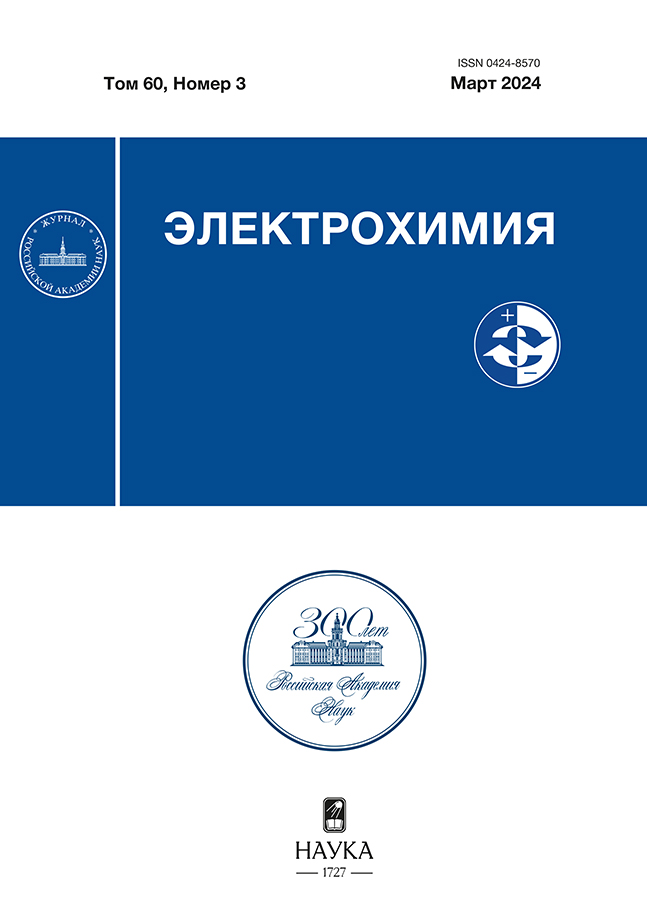Анализ характеристик батареи топливных элементов с протонообменной мембраной: влияние температуры окружающей среды
- Авторы: Фаддеев Н.А.1, Васюков И.В.1, Беличенко М.А.1, Серик А.В.1, Смирнова Н.В.1
-
Учреждения:
- Южно-Российский государственный политехнический университет (НПИ) имени М.И. Платова
- Выпуск: Том 60, № 3 (2024)
- Страницы: 191–197
- Раздел: Статьи
- URL: https://medjrf.com/0424-8570/article/view/671508
- DOI: https://doi.org/10.31857/S0424857024030048
- EDN: https://elibrary.ru/RBUTTV
- ID: 671508
Цитировать
Полный текст
Аннотация
Рассмотрена модель мембранно-электродного блока, учитывающая влияние различных климатических условий на удельные мощностные характеристики. Продемонстрирован анализ разработанной модели в сравнении с батареей топливных элементов с протонообменной мембраной (ПОМТЭ), работающей при различных температурах окружающей среды. Показано расхождение полученных данных (менее 10%) между моделью и экспериментом в диапазоне температур от −10 до +10°С. Оптимальная температура окружающей среды для работы батареи составила 10°C. Снижение удельной мощности при повышении температуры на каждые 10°C выше нуля составило 0.006–0.008 Вт/см2, что является несущественным изменением и может быть компенсировано за счет использования буферного накопителя энергии.
Ключевые слова
Полный текст
Об авторах
Н. А. Фаддеев
Южно-Российский государственный политехнический университет (НПИ) имени М.И. Платова
Автор, ответственный за переписку.
Email: nikita.faddeev@yandex.ru
Россия, Новочеркасск
И. В. Васюков
Южно-Российский государственный политехнический университет (НПИ) имени М.И. Платова
Email: nikita.faddeev@yandex.ru
Россия, Новочеркасск
М. А. Беличенко
Южно-Российский государственный политехнический университет (НПИ) имени М.И. Платова
Email: nikita.faddeev@yandex.ru
Россия, Новочеркасск
А. В. Серик
Южно-Российский государственный политехнический университет (НПИ) имени М.И. Платова
Email: nikita.faddeev@yandex.ru
Россия, Новочеркасск
Н. В. Смирнова
Южно-Российский государственный политехнический университет (НПИ) имени М.И. Платова
Email: smirnova_nv@mail.ru
Россия, Новочеркасск
Список литературы
- Kurnia, J.C., Chaedir, B.A., Sasmito, A.P., & Shamim, T., Progress on open cathode proton exchange membrane fuel cell: Performance, designs, challenges and future directions, Appl. Energy, 2021, vol. 283, p. 116359.
- Zhao, C., Xing, S., Chen, M., Liu, W., & Wang, H., Optimal design of cathode flow channel for air-cooled PEMFC with open cathode, Intern. J. Hydrogen Energy, 2020, vol. 45, no. 35, p. 17771.
- Jeong, S.U., Cho, E.A., Kim, H.J., Lim, T.H., Oh, I.H., & Kim, S.H., A study on cathode structure and water transport in air-breathing PEM fuel cells, J. Power Sources, 2006, vol. 159, no. 2, p. 1089.
- Wu, J., Galli, S., Lagana, I., Pozio, A., Monteleone, G., Yuan, X. Z., & Wang, H., An air-cooled proton exchange membrane fuel cell with combined oxidant and coolant flow, J. Power Sources, 2009, vol. 188, no. 1, p. 199.
- Sasmito, A.P., Birgersson, E., Lum, K., & Mujumdar, A.S., Fan selection and stack design for open-cathode polymer electrolyte fuel cell stacks, Renew. Energy, 2012, vol. 37, no. 1, p. 325.
- Sasmito, A.P., Birgersson, E., and Mujumdar, A.S., A novel flow reversal concept for improved thermal management in polymer electrolyte fuel cell stacks, Intern. J. Therm. Sci., 2012, vol. 54, p. 242.
- Sasmito, A.P., Lum, K.W., Birgersson, E., & Mujumdar, A.S., Computational study of forced air-convection in open-cathode polymer electrolyte fuel cell stacks, J. Power Sources, 2010, vol. 195, no. 17, p. 5550.
- Shahsavari, S., Desouza, A., Bahrami, M., & Kjeang, E., Thermal analysis of air-cooled PEM fuel cells, Intern. J. Hydrogen Energy, 2012, vol. 37, no. 23, p. 18261.
- Akbari, M., Tamayol, A., and Bahrami, M., Thermal assessment of convective heat transfer in air-cooled PEMFC stacks: an experimental study, Energy Procedia, 2012, vol. 29, p. 1.
- Faddeev, N., Anisimov, E., Belichenko, M., Kuriganova, A., & Smirnova, N., Investigation of the Ambient Temperature Influence on the PEMFC Characteristics: Modeling from a Single Cell to a Stack, Processes, 2021, vol. 9, no. 12, p. 2117.
- Bhaiya, M., Putz, A., and Secanell, M., Analysis of non-isothermal effects on polymer electrolyte fuel cell electrode assemblies, Electrochim. Acta, 2014, vol. 147, p. 294.
- Springer, T.E., Zawodzinski, T.A., and Gottesfeld, S., Polymer electrolyte fuel cell model, J. Electrochem. Soc., 1991, vol. 138, no. 8, p. 2334.
- Natarajan, D. and Van Nguyen, T., A two-dimensional, two-phase, multicomponent, transient model for the cathode of a proton exchange membrane fuel cell using conventional gas distributors, J. Electrochem. Soc., 2001, vol. 148, no. 12, p. A1324.
- Plawsky, J. L., Transport Properties of Materials, Transport Phenomena Fundamentals. CRC Press, 2020. p. 81-128.
- Weber, A.Z., Borup, R.L., Darling, R.M., Das, P.K., Dursch, T.J., Gu, W., & Zenyuk, I.V., A critical review of modeling transport phenomena in polymer-electrolyte fuel cells, J. Electrochem. Soc., 2014, vol. 161, no. 12, p. F1254.
- Holzer, L., Pecho, O., Schumacher, J., Marmet, P., Stenzel, O., Büchi, F.N., & Münch, B., Microstructure-property relationships in a gas diffusion layer (GDL) for Polymer Electrolyte Fuel Cells, Part I: effect of compression and anisotropy of dry GDL, Electrochim. Acta, 2017, vol. 227, p. 419.
- Holzer, L., Pecho, O., Schumacher, J., Marmet, P., Stenzel, O., Büchi, F.N., & Münch, B., Microstructure-property relationships in a gas diffusion layer (GDL) for Polymer Electrolyte Fuel Cells, Part II: pressure-induced water injection and liquid permeability, Electrochim. Acta, 2017, vol. 241, p. 414.
- Vetter, R. and Schumacher, J. O., Experimental parameter uncertainty in proton exchange membrane fuel cell modeling. Part II: Sensitivity analysis and importance ranking, J. Power Sources, 2019, vol. 439, p. 126529.
- Vichard, L., Petrone, R., Harel, F., Ravey, A., Venet, P., & Hissel, D., Long term durability test of open-cathode fuel cell system under actual operating conditions, Energy Convers. Manag., 2020, vol. 212, p. 112813.
Дополнительные файлы

Примечание
Публикуется по материалам IX Всероссийской конференции с международным участием “Топливные элементы и энергоустановки на их основе”, Черноголовка, 2022.












